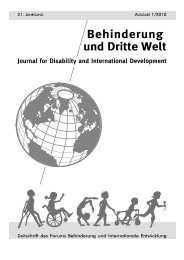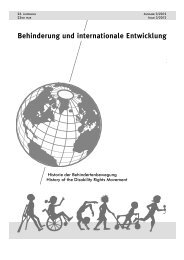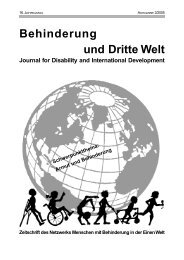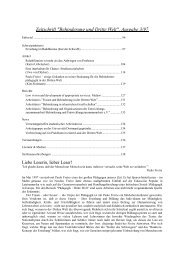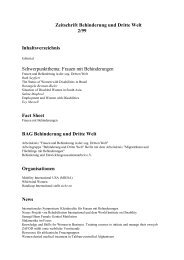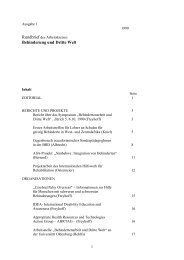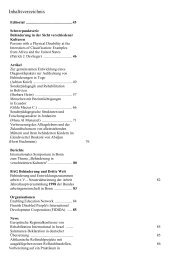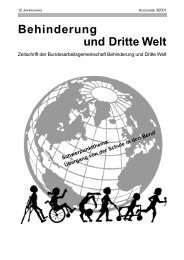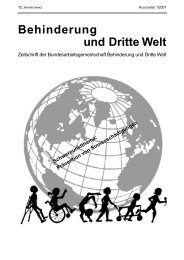Zeitschrift Behinderung und Dritte Welt
Zeitschrift Behinderung und Dritte Welt
Zeitschrift Behinderung und Dritte Welt
You also want an ePaper? Increase the reach of your titles
YUMPU automatically turns print PDFs into web optimized ePapers that Google loves.
B ERICHTESummary: E-Discussion on Women withDisabilities in DevelopmentWomen with disabilities are consistently among themost marginalized populations in all societies, includingin developing countries. This marginalizationcan - and often does - catapult women with disabilitiesinto poverty and exclude them from their ownhomes and communities. In order to increase thevisibility and <strong>und</strong>erstanding of issues affectingwomen with disabilities worldwide among the WorldBank and other organizations, the Global Partnershipfor Disability & Development (GPDD) along withthe World Bank’s Disability & Development Team(part of the Social Protection Sector of the HumanDevelopment Network), Gender & DevelopmentGroup and Office of Diversity Programs, held an InternationalRo<strong>und</strong>table Panel Discussion on Womenwith Disabilities in Development on March 10th,2009 in Washington, DC.During this event, the World Bank Vice Presidentof the Human Development Network, Joy Phumaphilaunched a two-week E-Discussion (March 10 –March 25, 2009) on women with disabilities in development.The E-Discussion brought together morethan 140 individuals worldwide. Many of whomwere women with disabilities. Some countries representedinclude Australia, Bangladesh, Germany, India,Jamaica, Kosovo, Malaysia, Mexico, Mongolia,New Zealand, Nigeria, Pakistan, the Philippines,and the U.S. The forum played an important role inconsolidating knowledge and raising awareness asto the lived experience of women with disabilities indeveloping countries and how to better ensure theirparticipation in development efforts.The thematic topics posed for discussion included:framing the issue of women with disabilitiesin development; reproductive health of women withdisabilities; violence and access to justice; educationof women with disabilities; women with disabilitiesand the environment; women with disabilities andemployment; and ways to ensure that women withdisabilities claim their place in the developmentagenda. In addition to the themes used to structurethe overall flow of discussion, participants alsoraised, and discussed, additional topics such as infrastructureand accessibility issues, refugee populations,sanitation issues; and caregiving, among others.The barriers women with disabilities face can becategorized according to the three following types:social and environmental; development program/organizational;and with regard to policy dialogue.During the E-Discussion, participants stressedthat the rights and needs of women with disabilitiesare often overlooked given widespread misconceptionsabout women with disabilities and neglect ofeven minor environmental adjustments that couldenable access to basic social services. For example,women with disabilities are often considered asexualor incapable of being a wife or a mother. As a result,participants noted that women with disabilities areoften not provided adequate health care services orinformation, or they may be forcibly sterilized.Women with disabilities also face extreme barriers inaccessing education and employment. In developingcountries, most schools have no wheelchair access,Braille materials, or other features for students withdisabilities, which leads to their exclusion from theeducation system altogether. Employers, for example,may refuse to hire disabled employees on thebasis of concerns that they will need more medicalleave than non-disabled employees. These forms ofdiscrimination, and others, only reinforce the socioeconomicexclusion – and dependence – of womenwith disabilities.Both sexual and domestic violence is a part of thelived experience of many women with disabilitiesworldwide. While women with disabilities have beenfo<strong>und</strong> to be at higher risk of such violence than theirnon-disabled counterparts, often assistance programsand existing legal systems are unfit to addresstheir needs. For example, assistance programworkers may be unfamiliar with how to obtain signlanguage interpreters or their offices may have nowheelchair ramps. In some cases, the law does notafford equal protection to women with disabilitiescompared to women without disabilities. Womenwith disabilities, more likely to be illiterate, may beless equipped to advocate for themselves in legalfora. As a result, women with disabilities often donot report violence. Women who are dependent ona caregiver for their economic and physical caremay, as a result, perceive no option for escape iftheir caregiver becomes violent.Daily life is characterized in many settings by aphysically disabling environment in which governmentbuildings, local businesses and even their ownhomes may be inaccessible for women with disabilities.This further restricts the likelihood of participatingin community and development activities outsidethe home. Moreover, these environments placethose with disabilities are heightened risk in the caseof natural and man-made disasters because theymay be unable to escape danger. The E-Discussionalso highlighted the more marginalized populationsamong women with disabilities – including girls andwomen with learning disabilities, those who are les-42 <strong>Zeitschrift</strong> <strong>Behinderung</strong> <strong>und</strong> <strong>Dritte</strong> <strong>Welt</strong> 3/2009



